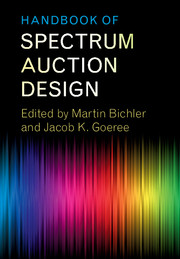Book contents
- Frontmatter
- Contents
- List of Contributors
- Preface
- List of Papers
- Part I The Simultaneous Multiple-Round Auction
- Part II The Combinatorial Clock Auction Designs
- Part III Alternative Auction Designs
- Part IV Experimental Comparisons of Auction Designs
- 25 Experiments Testing Multiobject Allocation Mechanisms
- 26 Laboratory Experimental Testbeds: Application to the PCS Auction
- 27 An Experimental Test of Flexible Combinatorial Spectrum Auction Formats
- 28 On the Impact of Package Selection in Combinatorial Auctions: An Experimental Study in the Context of Spectrum Auction Design
- 29 Do Core-Selecting Combinatorial Clock Auctions Lead to High Efficiency? An Experimental Analysis of Spectrum Auction Designs
- 30 Spectrum Auction Design: Simple Auctions For Complex Sales
- Part V The Bidders’ Perspective
- Part VI Secondary Markets and Exchanges
- Outlook
- References
29 - Do Core-Selecting Combinatorial Clock Auctions Lead to High Efficiency? An Experimental Analysis of Spectrum Auction Designs
from Part IV - Experimental Comparisons of Auction Designs
Published online by Cambridge University Press: 26 October 2017
- Frontmatter
- Contents
- List of Contributors
- Preface
- List of Papers
- Part I The Simultaneous Multiple-Round Auction
- Part II The Combinatorial Clock Auction Designs
- Part III Alternative Auction Designs
- Part IV Experimental Comparisons of Auction Designs
- 25 Experiments Testing Multiobject Allocation Mechanisms
- 26 Laboratory Experimental Testbeds: Application to the PCS Auction
- 27 An Experimental Test of Flexible Combinatorial Spectrum Auction Formats
- 28 On the Impact of Package Selection in Combinatorial Auctions: An Experimental Study in the Context of Spectrum Auction Design
- 29 Do Core-Selecting Combinatorial Clock Auctions Lead to High Efficiency? An Experimental Analysis of Spectrum Auction Designs
- 30 Spectrum Auction Design: Simple Auctions For Complex Sales
- Part V The Bidders’ Perspective
- Part VI Secondary Markets and Exchanges
- Outlook
- References
Summary
Introduction
There has been a long discussion on appropriate auction mechanisms for the sale of spectrum rights (Porter and Smith, 2006). Since 1994, the Simultaneous Multi-Round Auction (SMRA) has been used worldwide (Milgrom, 2000). The SMRA design was very successful, but also led to a number of strategic problems for bidders (Cramton, 2013). The exposure problem is central and refers to the risk for a bidder to make a loss due to winning only a fraction of the bundle of items (or blocks of spectrum) he has bid on at a price which exceeds his valuation of the won subset.
Combinatorial auctions (CAs) allow for bids on indivisible bundles avoiding the exposure problem. The design of such auctions, however, led to a number of fundamental problems, and many theoretical and experimental contributions during the past ten years (Cramton et al., 2006b). The existing experimental literature comparing SMRAs and CAs suggests that in the presence of significant complementarities in bidders’ valuations and a setting with independent private and quasi-linear valuations, combinatorial auctions achieve higher efficiency than simultaneous auctions (Banks et al., 1989; Ledyard et al., 1997; Porter et al., 2003; Kwasnica et al., 2005; Brunner et al., 2010; Goeree and Holt, 2010). Since 2008 several countries such as the U.K., Ireland, the Netherlands, Denmark, Austria, Switzerland, and the U.S. have adopted combinatorial auctions for selling spectrum rights (Cramton, 2013). While the U.S. used an auction format called Hierarchical Package Bidding (HPB) (Goeree and Holt, 2010), which accounts for the large number of regional licenses, the other countries used a Combinatorial Clock Auction (CCA) (Maldoom, 2007; Cramton, 2009), a two-phase auction format with primary bid rounds (aka. clock phase) for price discovery, which is extended by a supplementary bids round (aka. supplementary phase). The CCA design used in those countries has a number of similarities to the Clock-Proxy auction, which was proposed by Ausubel et al. (2006). It was used for the sale of blocks in a single spectrum band (i.e., paired and unpaired blocks in the 2.6 GHz band) and for the sale of multiple bands in Switzerland.
Although, spectrum auction design might appear specific, the application is a representative of a much broader class of multi-object markets as they can be found in logistics and industrial procurement. Spectrum auctions are very visible in public and successful designs are a likely role model for other domains as well.
Information
- Type
- Chapter
- Information
- Handbook of Spectrum Auction Design , pp. 640 - 671Publisher: Cambridge University PressPrint publication year: 2017
